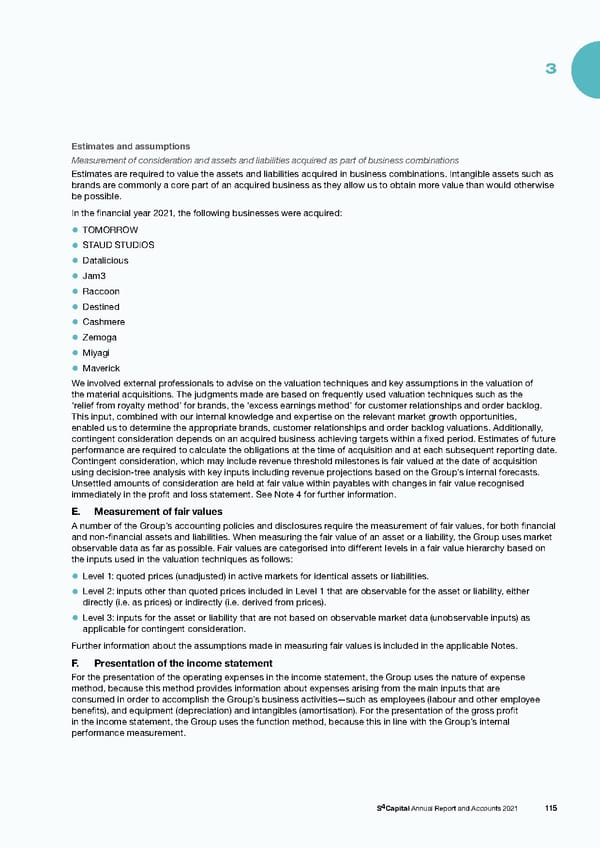3 Estimates and assumptions Measurement of consideration and assets and liabilities acquired as part of business combinations Estimates are required to value the assets and liabilities acquired in business combinations. Intangible assets such as brands are commonly a core part of an acquired business as they allow us to obtain more value than would otherwise be possible. In the financial year 2021, the following businesses were acquired: • TOMORROW • STAUD STUDIOS • Datalicious • Jam3 • Raccoon • Destined • Cashmere • Zemoga • Miyagi • Maverick We involved external professionals to advise on the valuation techniques and key assumptions in the valuation of the material acquisitions. The judgments made are based on frequently used valuation techniques such as the ‘relief from royalty method’ for brands, the ‘excess earnings method’ for customer relationships and order backlog. This input, combined with our internal knowledge and expertise on the relevant market growth opportunities, enabled us to determine the appropriate brands, customer relationships and order backlog valuations. Additionally, contingent consideration depends on an acquired business achieving targets within a fixed period. Estimates of future performance are required to calculate the obligations at the time of acquisition and at each subsequent reporting date. Contingent consideration, which may include revenue threshold milestones is fair valued at the date of acquisition using decision-tree analysis with key inputs including revenue projections based on the Group’s internal forecasts. Unsettled amounts of consideration are held at fair value within payables with changes in fair value recognised immediately in the profit and loss statement. See Note 4 for further information. E. Measurement of fair values A number of the Group’s accounting policies and disclosures require the measurement of fair values, for both financial and non-financial assets and liabilities. When measuring the fair value of an asset or a liability, the Group uses market observable data as far as possible. Fair values are categorised into different levels in a fair value hierarchy based on the inputs used in the valuation techniques as follows: • Level 1: quoted prices (unadjusted) in active markets for identical assets or liabilities. • Level 2: inputs other than quoted prices included in Level 1 that are observable for the asset or liability, either directly (i.e. as prices) or indirectly (i.e. derived from prices). • Level 3: inputs for the asset or liability that are not based on observable market data (unobservable inputs) as applicable for contingent consideration. Further information about the assumptions made in measuring fair values is included in the applicable Notes. F. Presentation of the income statement For the presentation of the operating expenses in the income statement, the Group uses the nature of expense method, because this method provides information about expenses arising from the main inputs that are consumed in order to accomplish the Group’s business activities—such as employees (labour and other employee benefits), and equipment (depreciation) and intangibles (amortisation). For the presentation of the gross profit in the income statement, the Group uses the function method, because this in line with the Group’s internal performance measurement. S4Capital Annual Report and Accounts 2021 115
 s4 capital annual report and accounts 2021 Page 116 Page 118
s4 capital annual report and accounts 2021 Page 116 Page 118